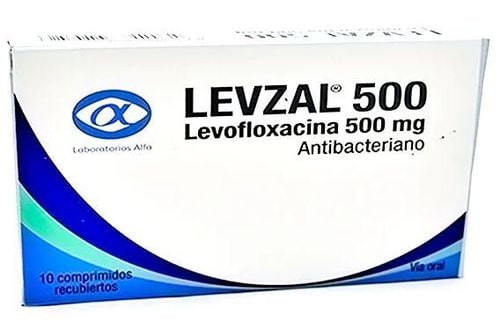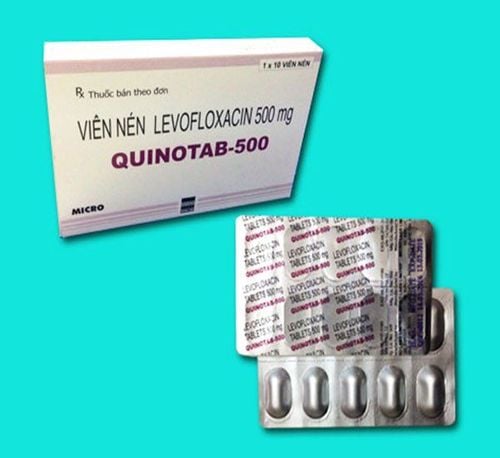This is an automatically translated article.
Aulox 500mg drug is made in the form of tablets, with the main ingredient being Levofloxacin. The drug is used in the treatment of infections caused by bacteria sensitive to Levofloxacin.
1. What does Aulox 500mg do?
Aulox 500mg drug has the main ingredient Levofloxacin 500mg. Levofloxacin is a broad-spectrum synthetic antibiotic of the fluoroquinolone group, which is active against many strains of gram-positive and gram-negative bacteria. Levofloxacin has a bactericidal effect due to its ability to inhibit topoisomerase II or topoisomerase IV enzymes - essential enzymes of bacteria, participating in catalysis in the processes of replication, transcription, and repair of bacterial DNA.
Indications for use of Aulox 500mg: Treatment of infections caused by bacteria sensitive to Levofloxacin such as:
Community-acquired pneumonia; Prostatitis; Acute sinusitis ; Acute exacerbation of chronic bronchitis; Urinary tract infections (with/without complications); Skin and subcutaneous tissue infections (with/without complications); Prophylaxis after exposure, radical treatment of anthrax. Contraindications to the use of Aulox 500mg:
People with a history of hypersensitivity to Levofloxacin, other quinolones or other components of the drug; Patients with epilepsy, G6PD deficiency, history of tendon disease; Children under 18.
2. How to use and dose Aulox 500mg
Usage: Orally. The time of taking the drug does not depend on the meal, so it can be taken or taken away from the meal. Do not use antacids containing aluminum and magnesium, preparations containing heavy metals such as iron, zinc, didanosine, sucralfate within 2 hours before and after taking the drug. While taking the drug, the patient should drink plenty of water every day.
Dosage:
Exacerbation of chronic bronchitis: 500mg/time/day for 7 days; Community-acquired pneumonia: 500mg x 1-2 times/day, treatment for 7-14 days; Acute maxillary sinusitis: 500mg/time/day for 10-14 days; Skin and subcutaneous tissue infections: Complicated: Use 750mg/time/day for 7-14 days; No complications: Use 500mg/time/day for 7-14 days; Urinary tract infections: Complicated: 250mg/time/day for 10 days; No complications: Use 250mg/time/day for 3 days; Nephritis - acute pyelonephritis: Use dose 250mg/time/day, treat for 10 days; Anthrax: Prophylactic treatment after exposure to anthrax bacilli: 500mg/time, treatment for 8 weeks; Treatment of anthrax: Intravenous infusion, then oral medication if the patient's condition allows. Dosage 500mg/time/day, treatment for 8 weeks Prostatitis: 500mg/24 hours, intravenous infusion. After a few days, it is possible to switch to oral drugs; Patients with renal impairment: Adjust dose according to creatinine clearance; Patients with hepatic impairment: No dose modification is required. Overdose: In the presence of skin rash or hypersensitivity reactions, CNS adverse reactions, Levofloxacin should be discontinued. Patients should be monitored for pseudomembranous colitis, and appropriate management measures should be taken when diarrhea develops while taking levofloxacin. When signs of tendinitis appear, the drug should be discontinued, the two Achilles tendons rest with appropriate immobilizers, heel brace, and specialist consultation.
There is currently no specific antidote to Levofloxacin. The treatment of overdose is to remove the drug from the stomach and replace the patient with enough mucus. At the same time, ECG monitoring should be performed because of the phenomenon of prolonged QT interval.
Missed dose: If you forget to take a dose of Aulox 500mg, you should take it as soon as you remember. However, when it is almost time for your next dose, skip the missed dose and continue with your next dose as scheduled.
3. Side effects of Aulox 500mg
Some side effects patients may experience when using Aulox 500mg:
Common, not too serious: Nausea, vomiting, abdominal pain, diarrhea, constipation, heartburn, vaginal itching, vaginal discharge, headache; Uncommon, serious: Severe diarrhea (bloody stools), with or without fever, stomach pain, dizziness, nervousness, confusion, restlessness, unprovoked suspicions, trouble sleeping or staying asleep , hallucinations, frequent nightmares or unusual dreams, depression, thoughts of death or suicide, etc. When experiencing these side effects, patients should call their doctor immediately, seek medical advice. doctor to see if the medication needs to be stopped; Rare, particularly serious: Rash, itchy skin, urticaria, peeling, blistering of the skin, swelling of the eyes, fever, swelling of the face - mouth - lips - tongue - throat - hands - feet - ankles legs-legs, hoarseness, fast heartbeat, trouble breathing, trouble swallowing, fainting, loss of consciousness, yellow eyes, jaundice, dark urine, seizures, decreased urination, unusual bruising or bleeding , muscle or joint pain. When experiencing these side effects or symptoms of tendonitis, tendon rupture, the patient should stop taking Aulox 500mg and immediately notify the doctor, call an ambulance immediately.
4. Be careful when using Aulox 500mg
Some notes for patients to remember before and while using Aulox 500mg:
Tendonitis, especially the heel tendon, can lead to tendon rupture, a complication that can appear in the first 48 hours after taking it. medicine Aulox 500mg. Tendonitis mainly occurs in people over 65 years of age, who are taking corticosteroids. To prevent this risk, the daily dose should be adjusted in elderly patients according to glomerular filtration rate; Levofloxacin may cause cartilage degeneration in gravity-bearing joints. Therefore, Levofloxacin should not be used in children under 18 years of age; Use caution when using Aulox 500mg in people with myasthenia gravis (because symptoms can be aggravated); There have been cases of adverse reactions such as increased intracranial pressure, psychosis, CNS stimulation leading to tremor, convulsions, restlessness, insomnia, headache, depression, confusion. , hallucinations, nightmares, suicidal thoughts or actions when using Aulox 500mg. If these adverse reactions occur, the drug should be discontinued and appropriate symptomatic management instituted. The drug should be used with caution in people with central nervous system diseases such as cerebral sclerosis, epilepsy,... because it increases the risk of convulsions; When using Levofloxacin, patients may experience hypersensitivity reactions, even anaphylaxis. The drug should be discontinued at the first signs of hypersensitivity reactions, and appropriate management measures should be taken immediately; When using Levofloxacin, patients may develop pseudomembranous colitis caused by Clostridium difficile. Attention should be paid to accurate diagnosis of cases of diarrhea occurring during the patient's use of the drug in order to have appropriate management interventions; Patients receiving Levofloxacin may develop photosensitivity (although the incidence is very low, less than 0.1%). Patients should avoid exposure to light during and 48 hours after treatment; Levofloxacin may cause disturbances in glucose metabolism, including hyper/low blood sugar (occurring in diabetic patients receiving levofloxacin together with a hypoglycemic agent or with insulin). Therefore, blood sugar should be monitored when taking the drug in patients with diabetes. If hypoglycaemia occurs, levofloxacin should be discontinued and appropriate management measures instituted; Use of Levofloxacin may cause prolongation of the QT interval on the electrocardiogram in some patients with arrhythmias. Therefore, the drug should be avoided in patients with pre-existing prolongation of the QT interval, patients with hypokalemia, taking antiarrhythmic drugs of class IA (quinidine, procainamide), class III (amidarone, sotalol), etc. At the same time, use caution when using Levofloxacin in patients with pre-arrhythmias such as bradycardia, acute myocardial ischemia.
5. Aulox 500mg . drug interactions
Some drug interactions of Aulox 500mg include:
Concurrent use of Aulox 500mg with Antacid, sucralfate, ion, metal, multivitamin may reduce the absorption of Levofloxacin. Therefore, these drugs should be taken at least 2 hours apart from Levofloxacin; Closely monitor theophylline concentration, adjust the dose if necessary when theophylline and levofloxacin are used concurrently; Warfarin is potentiated when used concurrently with Levofloxacin. Therefore, coagulation indices should be monitored if these two drugs are used concurrently; Concomitant use of nonsteroidal anti-inflammatory drugs with Levofloxacin may increase the risk of CNS irritation; Concomitant use of Levofloxacin with hypoglycemic agents may increase the risk of dysglycemia. Therefore, it is necessary to closely monitor the patient's health when combining these drugs. When prescribed Aulox 500mg, the patient should strictly follow all instructions of the doctor. As a result, the treatment will be more effective and reduce the risk of complications and unpredictable side effects.
Please dial HOTLINE for more information or register for an appointment HERE. Download MyVinmec app to make appointments faster and to manage your bookings easily.













